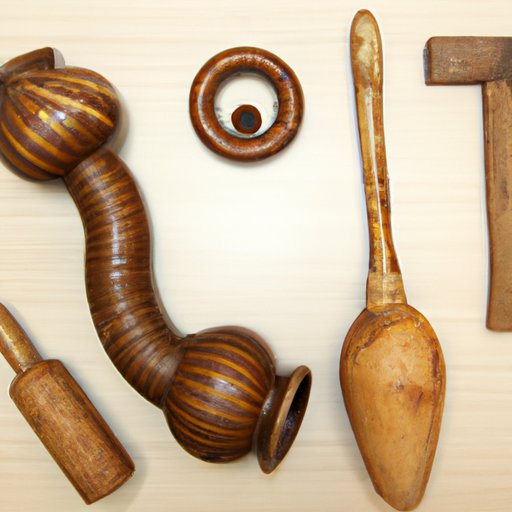
I. Introduction
There’s nothing quite like the frustration of dealing with a clogged toilet. Whether it’s caused by an excess of toilet paper, flushing non-degradable items, or other reasons, a clog can be a real headache. Fortunately, there are several different tools and methods you can use to unclog your toilet and get things flowing again. In this article, we’ll provide you with a comprehensive guide that includes everything you need to know about unclogging a toilet quickly and safely.
II. Comprehensive Guide to Unclogging a Toilet: Top 5 Tools to Do the Job
The five most effective tools for unclogging a toilet are a plunger, a drain auger, a toilet snake, a chemical drain cleaner, and a natural clog remover. Here’s a breakdown of how each tool works, along with their pros and cons:
- Plunger: This is the most commonly used tool for unclogging toilets. It creates suction that can force a blockage through the pipes. Plungers are inexpensive and safe for most toilets. However, they require some elbow grease to work and may not be effective for particularly stubborn clogs.
- Drain Auger: Also known as a plumbing snake, this tool has a long cable that can be stretched down your toilet’s pipes to dislodge stubborn blockages. Drain augers can be effective and safe for most toilets, but they may require some expertise to use properly.
- Toilet Snake: This tool is similar to a drain auger but is designed specifically for use in toilets. It’s more expensive than a plunger or drain auger but can be very effective for stubborn clogs.
- Chemical Drain Cleaner: These products come in liquid or powder form and contain harsh chemicals that dissolve blockages. Chemical drain cleaners can be effective but are also very hazardous and can damage your plumbing. They’re best used as a last resort.
- Natural Clog Remover: These remedies use natural ingredients, such as vinegar, baking soda, or dish soap to dissolve blockages. Natural clog removers are typically safe and effective, especially for minor clogs.
III. Discover the Best Home Remedies to Unclog Your Toilet
If you prefer natural remedies, you’ll be glad to know that many of them can be found in your household, including:
- Vinegar and Baking Soda Mixture: This mixture is poured into the toilet bowl and left for several minutes to loosen the clog. Afterward, you can flush the toilet to clear the blockage.
- Dish Soap and Hot Water: This method requires you to add water and a few drops of dish soap into your toilet bowl, then wait a few minutes before flushing the toilet.
- Wire Hanger: This is a last resort method and may not be the safest. Take a wire hanger, unwind it, and then create a hook out of one end. This hook is inserted into the clogged drain to break apart and remove debris.
IV. DIY Plumbing: Easy Ways to Unclog Your Toilet
If you prefer to stick to basic plumbing, these simple steps can help you unclog your toilet:
- Use a Plunger: Make sure your plunger creates a tight seal around the toilet bowl’s hole. Plunge the toilet with force several times, repeating as necessary.
- Use a Toilet Auger: Insert the end of the auger into the toilet bowl’s hole and guide it carefully through the clog, then repeat the process a few times.
- Use a Drain Snake: Insert the snake down the toilet drain until it reaches the clog. Twist and push the snake until it breaks apart or removes the blockage.
V. Unclogging Toilets with Chemical Drain Cleaners: Are They Safe?
Chemical drain cleaners can be effective, but they’re also very hazardous, and using them incorrectly can cause significant damage to your plumbing fixtures. In some cases, they may not work at all. It’s best to use this method only when all other methods have failed, and it is best left to professionals who know how to handle them properly.
VI. 5 Reasons Why Your Toilet Keeps Clogging and How to Avoid Them
Prevention is the best way to avoid toilet clogs. Here are five reasons why your toilet may keep clogging, and what you can do to avoid them:
- Flushing Non-degradable Items: Avoid flushing baby wipes, feminine hygiene products, and other items that don’t easily dissolve in water.
- Using Too Much Toilet Paper: Try using less toilet paper with each flush or switch to a brand that dissolves more easily.
- Low Water Pressure: Check your toilet’s water supply and pressure if you find that the plunger is no longer able to clear the clog.
- Contact a Professional: If your toilet keeps clogging, it may be an underlying plumbing issue that requires professional help. A professional plumber can diagnose the issue and offer a solution.
VII. Conclusion
Dealing with a clogged toilet can be a frustrating and messy experience, but thankfully, there are many ways to remedy the situation. From using natural remedies to DIY plumbing and professional help, you can find a solution that suits you. As always, preventive measures are the best way to avoid clogs, so be sure to flush only appropriate materials and use your toilet properly to keep it in working order.




